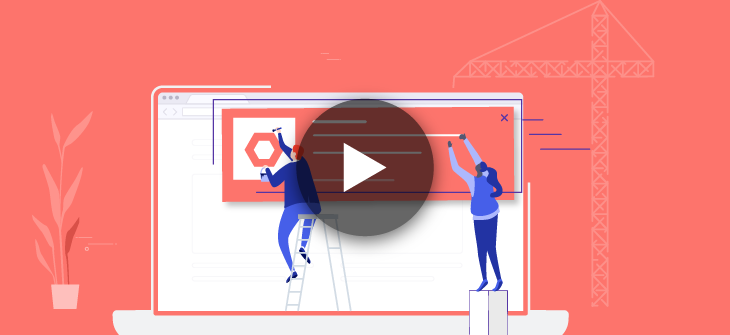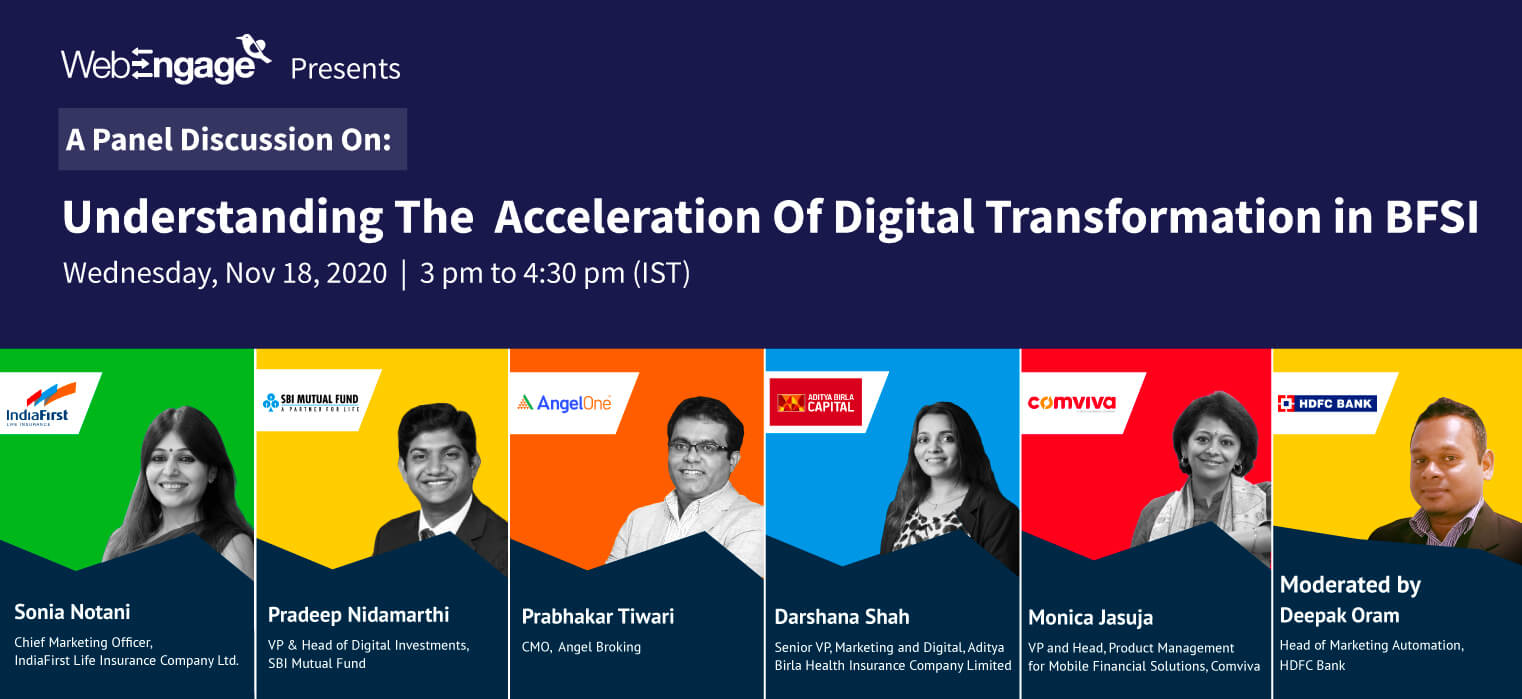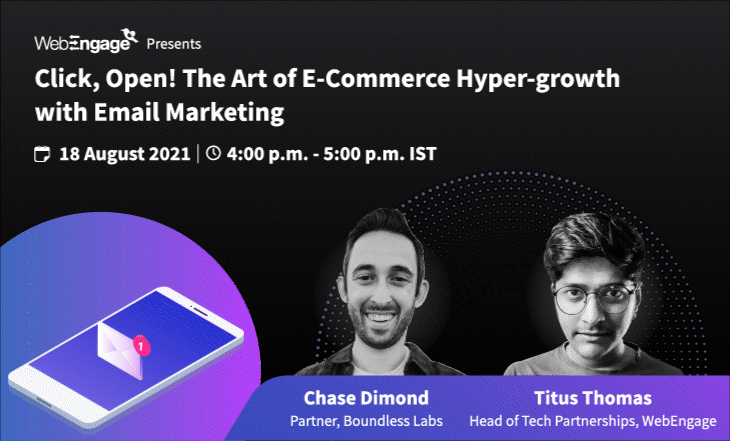Webinar Transcript
Avantika: All right. Thank you for your patience. Hello, and welcome to this webinar by WebEngage. My name is Avantika Pandey, and I’m the community manager of WebEngage and the moderator for today’s Webinar. Before we go any further, here are a few housekeeping topics.
First, you’ll be on the listen-only mode. Second, we’ll have the Q&A session at the end of this Webinar. But if you have any query during the session, you can put it in the comment box below. Third, we’ll be recording today’s webinar, and we’ll send you the recording in a couple of days. Also, the part two of this webinar series is scheduled on 20th September.

We have already left a registration link in the comment box below, so you can please register over there. Now, for those who don’t know, WebEngage is a marketing cloud for consumer businesses. More than 40,000 online brands are using our platform to automate their communication across users’ life cycle via email, push, in-app, onsite, SMS and our favorite, web push. Now, you must be thinking why web push is our favorite. Because, in just a short span of two and a half years, this engagement channel has made its way to every multi-channel marketing campaign across the globe.
Today, Milisha, who’s also customer success manager at WebEngage, will give us an elementary lesson on what is web push notification. Over to you, Milisha.
Milisha: Hi, everyone. Welcome to “Getting Started with Web Push Notifications.” I am Milisha. I handle presales accounts for some of the largest online brands here at WebEngage. This is our agenda for our webinar today. We will be touching up on what is web push, how does it work, and, the most important, why and how you should use this channel. You see, web push or browser push notifications has so much potential. It is a relatively new channel and has been grossly underutilized as a channel of communication. Usually, the sentiments around this channel is that it isn’t very effective and can’t be counted as an optimal channel. Most don’t know how to use it. Through this webinar, I aim to dispel some of these notions and show you some ways to get started with web push.
First, let’s come to, “What is web push?”
“Web push allows you to effectively engage with users who have opted in with relevant, customized, and personalized content in the form of timely updates.”

The critical thing here is to get opt-in from your user, and this is the reason why this channel is very effective, because the receiver of these messages has actually opted in to receive the communication from you. And we’ll learn about how to get opt-ins and their process in a few minutes.
Let’s come to the second most frequently asked question. How is it different from onsite or web notifications?
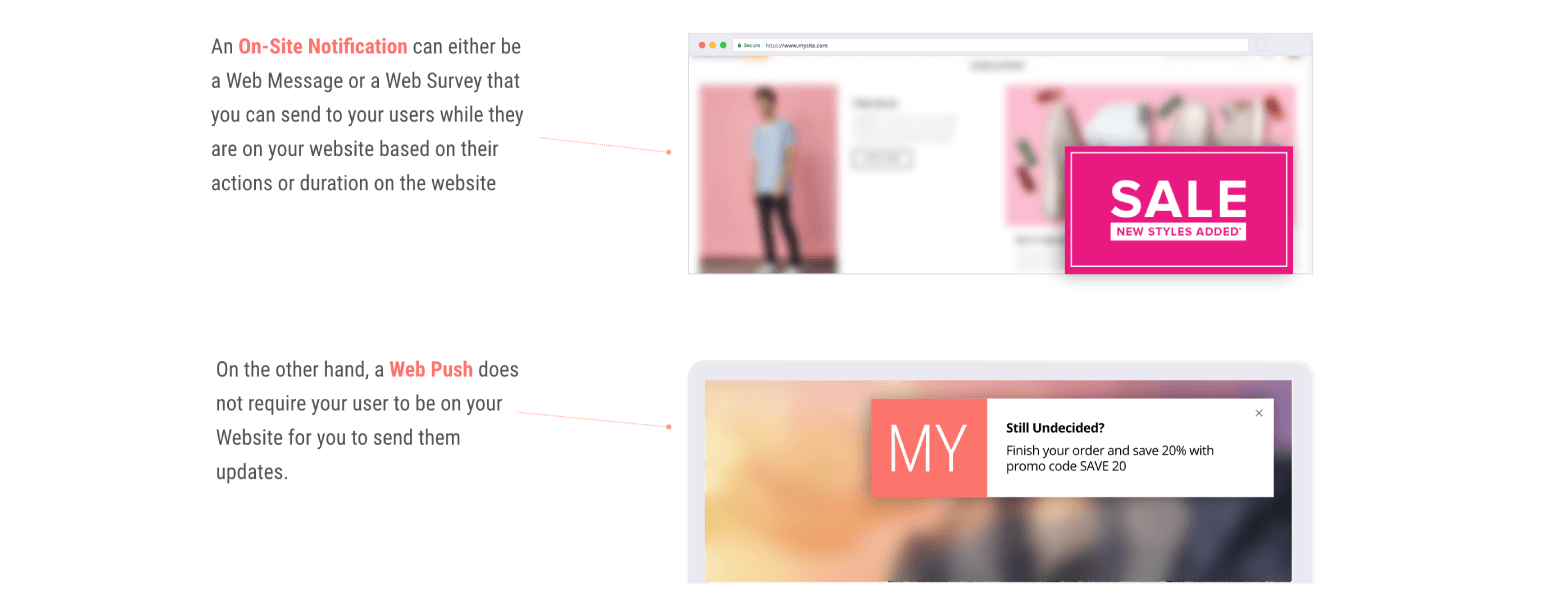
An onsite notification can either be a web message, the kind that you can see right now on the screen, or a web survey that you can send to your users while they are on your website based on their actions or the duration on the site. Your user has to be on your website for you to send them an onsite notification. On the other hand, a web push notification does not require your user to be on your website for you to send them updates.
Where can you send these web push notifications?

Well, you can send them on all these devices and all these browsers. While you can send them on Android devices as well, it is currently unavailable for iOS phones completely.
So how does web push actually work?
You get your user to opt in with a prompt. They subscribe, and then they get added to a list of your users. And you can then engage with them by sending them the actual web push notifications. But the best part about web push, unlike any other channel like email, SMS, or push notification, is that you do not require a unique user identifier like an email ID or mobile number. You do not need an app, and your user does not necessarily need to be on your website. You just require the user to opt-in once, and that’s it. That’s how you can start sending web push notifications.
So what is these opt-ins that we’re talking about?
- Single opt-in method
- Double opt-in method
Well, there are two opt-in methods. The first is a single opt-in method.

For this, you need to have a HTTPS website for you to send this kind of an opt-in message to your user. That said, single opt-ins, according to our study, has the highest opt-in rate. So this is the kind of message that will pop up on the left-hand side of your user’s browser.
When they click on Allow, you can directly start sending them web push notifications.
Coming to the double opt-in method.
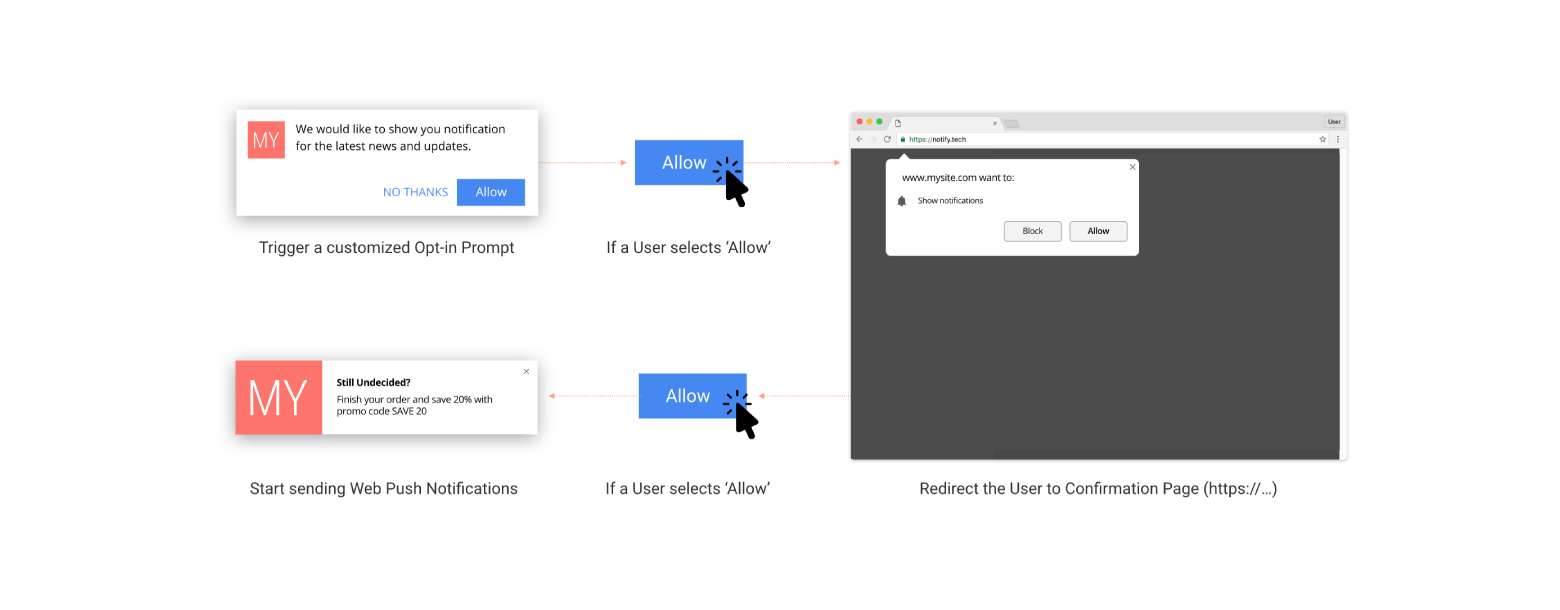
Now, this process is a little bit lengthy, but you can get creative when you’re asking your user to opt in here. You show them a message while they are on your website, which will look something like this. If your user selects Allow, another window will pop up asking them to, you know, click on Allow once again. And if they click Allow on that particular window, you can start sending them web push notifications. So these are, you know, the two opt-in methods which you can use effectively to increase your opt-ins.
Then we come to, “How do I create actual web push?
This is how you create a web push notification
So you get a dropdown of your events that are available. You get to send those as a trigger on the basis of which you can send the communication. You set your campaign start dates and end dates, and that’s it. That’s your triggering logic. Then you set up your DND and frequency capping settings. This is something that Lithin will cover more in detail in the upcoming session, and that is it. This is all that you have to do to set up and send out your web push notifications.
The second part that you come to is the triggering rules, or the sending rules.
Within the triggering rules, you get to define whom you want to send this web push to and where do you want to send it to them, or when do you want to send it to them. Will it be a one-time web push notification? Do you want to schedule it on a weekly, daily, or a monthly basis on a specific day, on a specific time, or if you want to send this web push on the basis of a trigger?
So you get a dropdown of your events that are available. You get to send those as a trigger on the basis of which you can send the communication. You set your campaign start dates and end dates, and that’s it. That’s your triggering logic. Then you set up your DND and frequency capping settings. This is something that Lithin will cover more in detail in the upcoming session, and that is it. This is all that you have to do to set up and send out your web push notifications.
Coming to the next bit, we did a little analysis of web push campaigns going from the WebEngage dashboards, and more of these insights will come up ahead. But right now what I wanted to show you are some figures relating to opt-in.
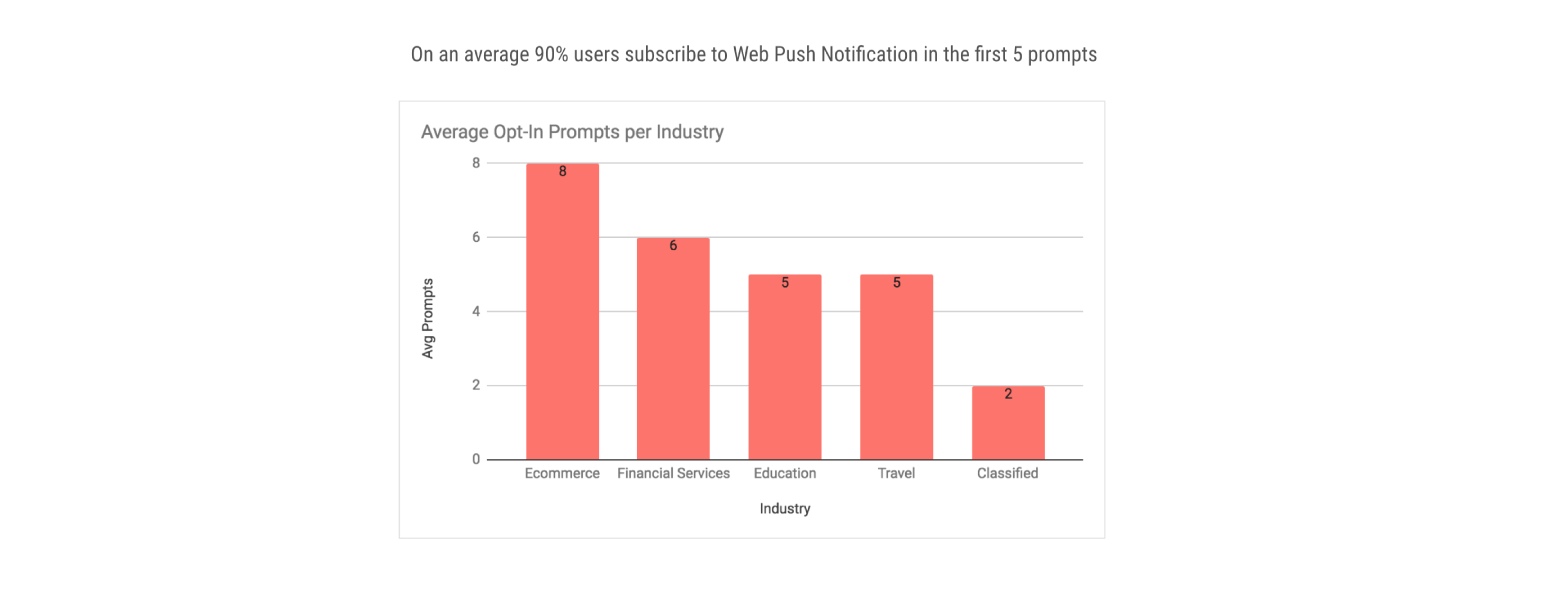
So, on an average, 90% of your users will subscribe to your web push within the first 5 prompts, which means, for your users to opt in, you will at least have to show them the web push notification for at least 5 times before they agree to opt in to receiving web push from you. What we also found out interestingly is that, while on weekdays, the time period between 2 p.m. and 8 a.m. seems to get the highest opt-in rates. On weekends, however, the opt-in rates are observed from 9 a.m. to 9 p.m. So, literally, on a weekday, you can, you know, send out your opt-in messages at any given point time of the day.
Now, keeping this in mind, we have a little insight as to how to increase your opt-in rates.
We would suggest incentivizing it. We showed an attractive onsite notification with an incentive of a discount coupon for users who subscribe to web push. Those who did subscribe to receiving web notifications from us were then sent a personalized coupon over a web push. Now, not only does this increase your opt-ins, you are also increasing your customers’ confidence by sending them a trigger message.
Moving along, we come to the main question, “Why should you use this channel?”
So, for your benefit, what we did was we analyzed some 2,239 campaigns and about a billion web push notifications, and we found out this.

Reason number one, the average opt-in rates can be as high as 11%. Can you think about it for a minute? You can reach out to a substantial chunk of your users over web push before you reach out over email or SMS. This will also probably substantially help you decrease your spends, your marketing spends. This brings us to the second stat, the average click-through rate or the CTR for web push, and you can see the CTR rates in greens for web push here.
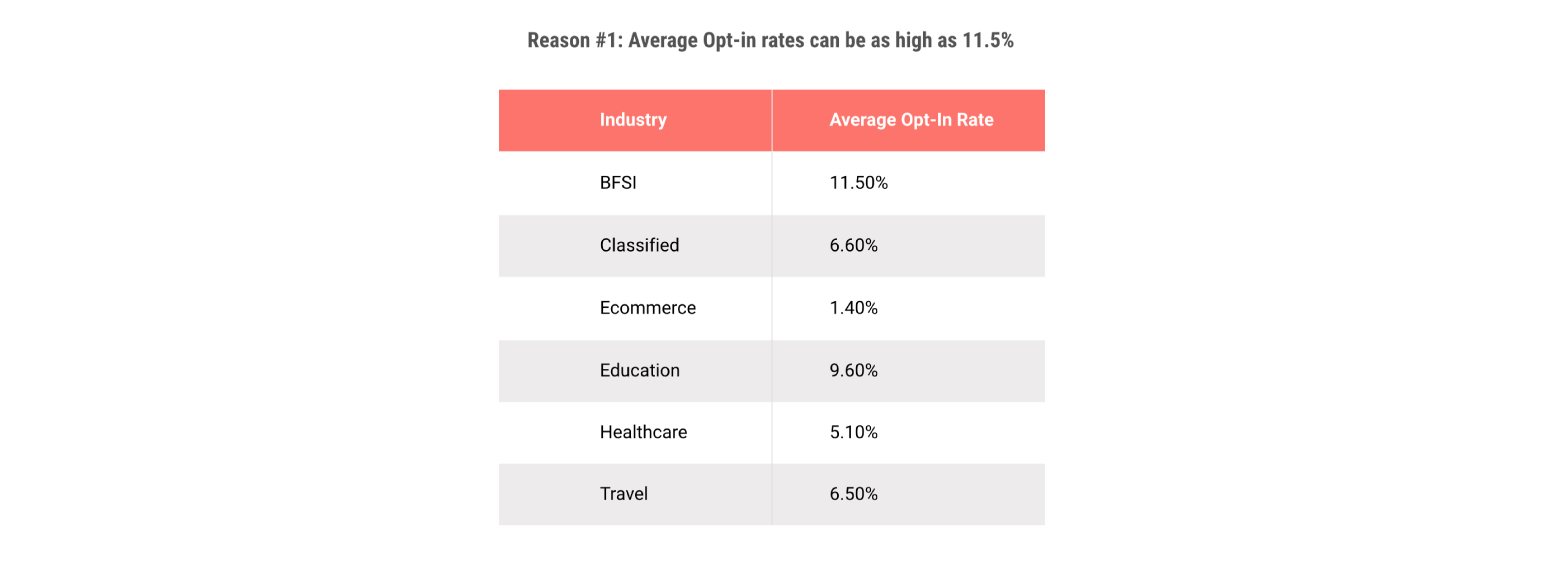
The average CTR for web push is relatively higher than email or SMS, and this is mainly because your user still has their browser open and can see the message immediately unlike in email where they will have to open their inbox again or, in case of an SMS, they may, you know, choose not to click on the link due to maybe connectivity issues. That’s why the CTR seems to be a little on the higher side for web push.
Now, this in turn is correlated to the fact that web push seems to have a better reachability than any other channel even across anonymous users that you can see in orange. You can see that, even for the anonymous users, the reachability seems to be on the higher side. This could be attributed to the fact that your users have greater control over opting in and opting out from receiving web push notifications.
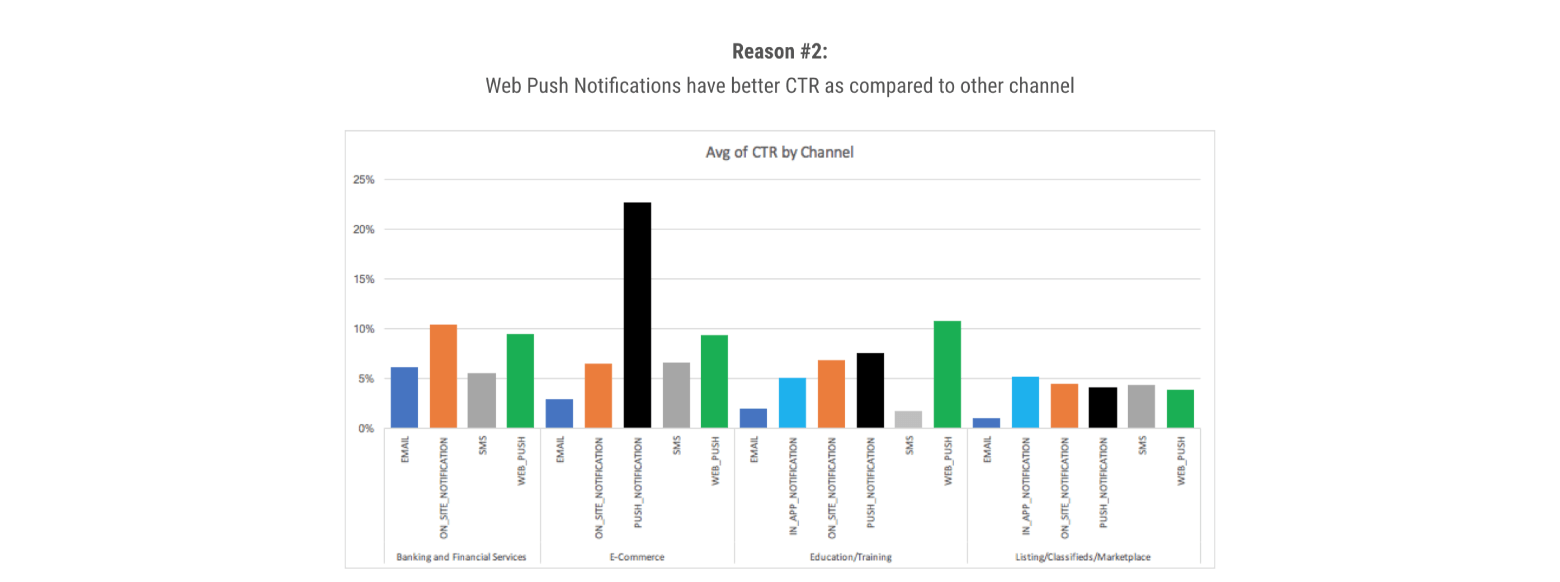
And the last stat that we wanted to show you is this, and this will be critical for our next part of the presentation, is that triggered web push or web pushes sent on the basis of a user’s activity performs better than site click or one-time web push. This is simply because your user is more likely to check a message based on the activity that they were just indulging in while they were on your website.
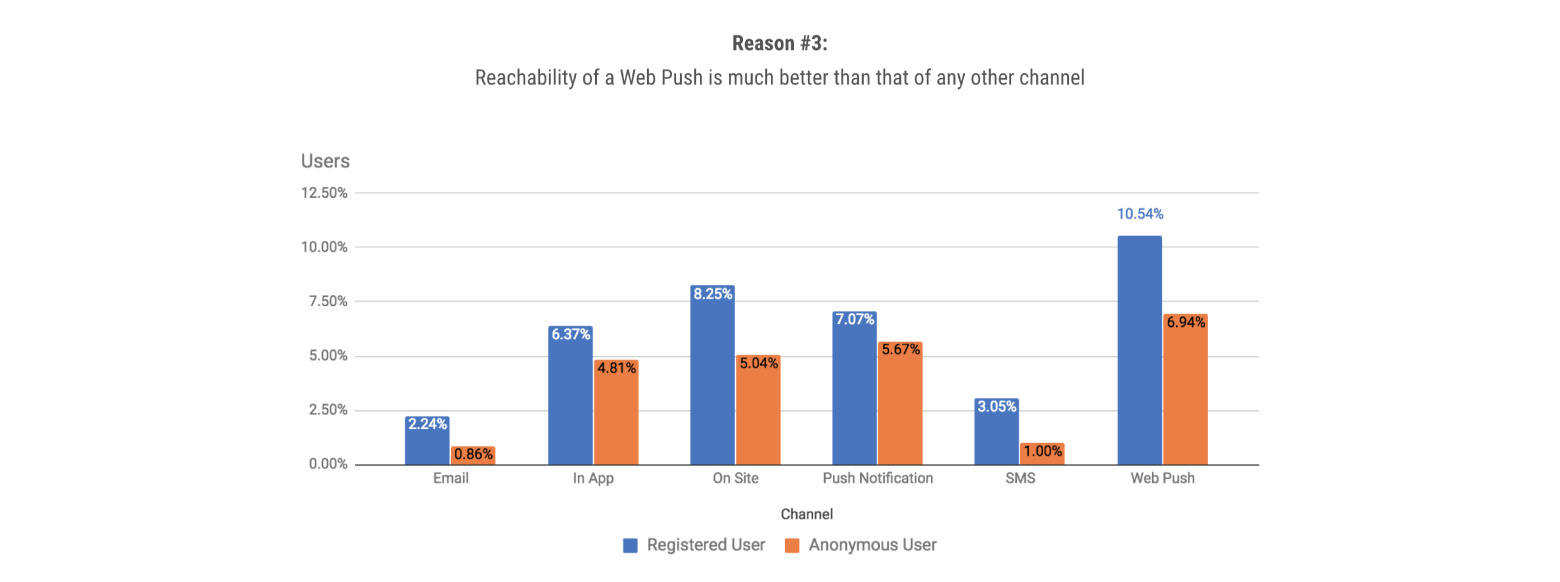
So what do these stats actually mean for a marketer like you?
Number one, you can reach out to your user first on web push before reaching out on email and SMS.
Number two, since the CTR is on the higher side, you have a higher chance of getting a conversion or a purchase from this guy and off a user.
And, number three, the more triggered or more activity-based your web push is, the higher are your chances of your user making a purchase.
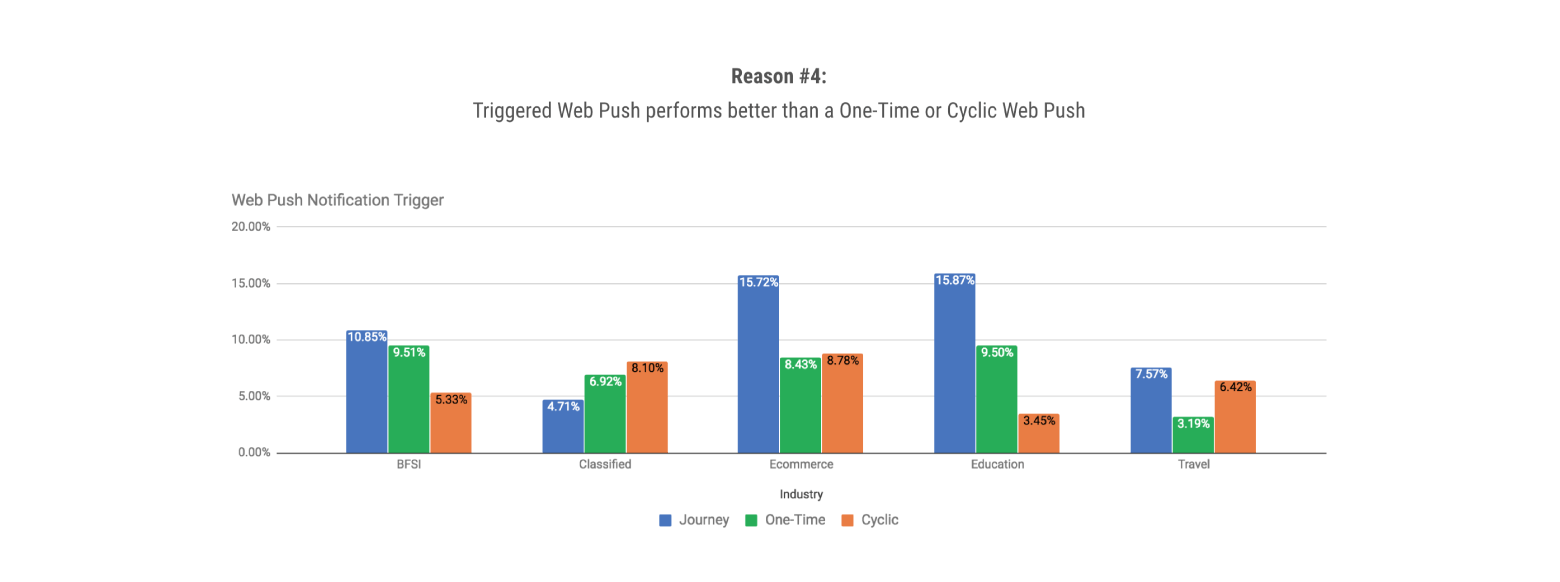
This brings us to the part of the presentation where we discuss about,
“How do I make the most of web push notifications?”
- Segment: Identified (registered) and Unidentified Users
- Objective: Send personalized and contextual discount via web push notification
Let me present this with a case study once again. This was done for one of our leading online travel agencies. The objective was to send contextual personalized web messages if a user would abandon their search for a flight. The problem here was that there would be identified as well as unidentified users. An unidentified user in this case would be a user who has not registered, and, therefore, we did not have their email ID or their mobile number. However, we could still track their behavior on the website. While we could reach out to an identified user on email and SMS, we would not have the same opportunity with the unidentified users. So here’s what we did.
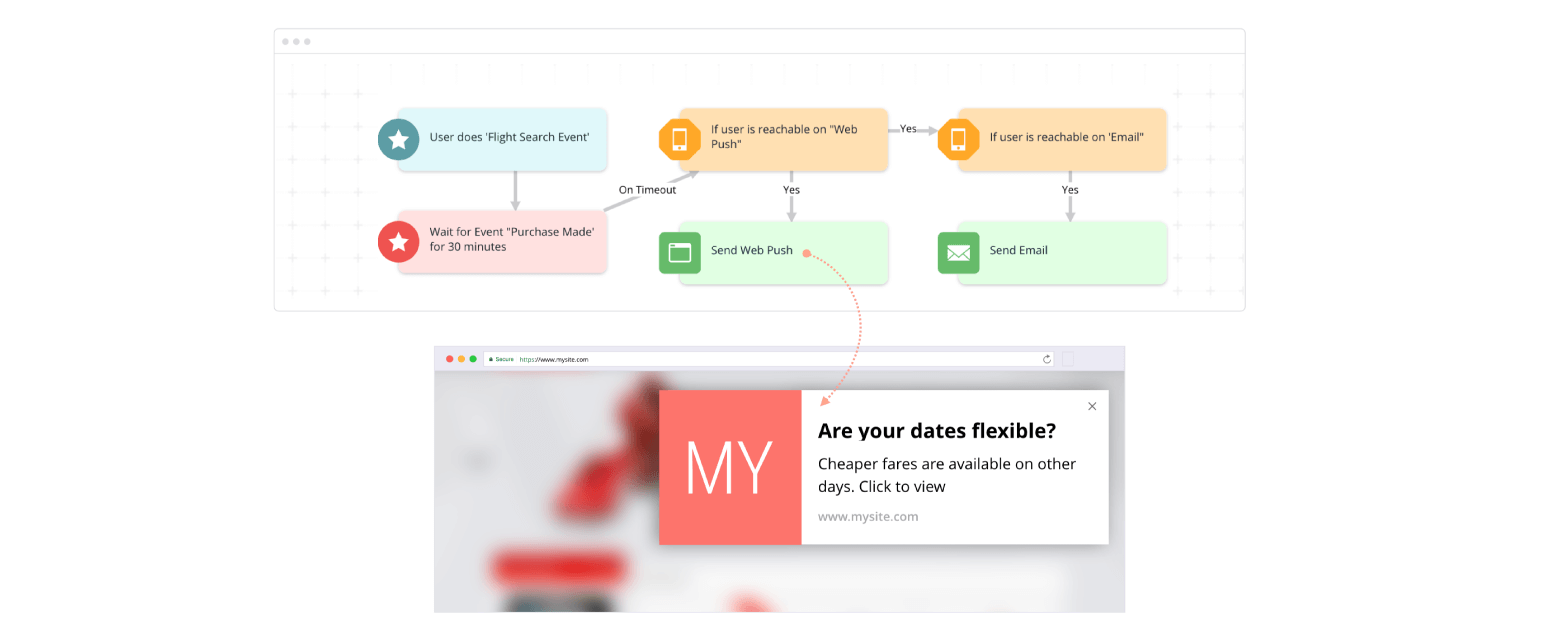
A user’s flight search would trigger the event, then we gave this user some time to make a purchase. We gave them about 30 minutes. If the user did not make a purchase or if this particular event timed out, we would check if this user was reachable on web push or not.
If they are, then we send them a message, which was extremely contextual, personalized based on what was their last activity, that was the flight search. And we ask them if they’re flexible with their dates so that we could suggest cheaper fares for their journey on other dates around the date that they were searching their flights for.
Now, this was highly contextual, and it was based on a trigger. Combined with the fact that trigger web push notifications perform much better, it drove some good conversions. This is what the stats look like.
So, out of the total number of users who were reachable on web push, we got some 89.4% impression, so that is 89.4% of users actually saw the message. Out of which 12.7% of users actually clicked on the web notification, and, out of those, 1.1% of users actually made a final purchase, which, in our opinion, is a pretty good conversion rate.

So, concluding this, I would like to reiterate what we just learned.
Number one, web push is another channel of communication that you can use to engage your users and get them back to your website. However, an opt-in is absolutely necessary before you start sending them communications, and this channel does seem to have a much better performance than other channels.
Before we end, I would also like to mention that, as a marketer, be weary of, you know, overusing or misusing this channel, or it creates a messaging fatigue in the minds of your users. The need right now is to send web push which is more targeted in nature rather than your spray and pray techniques. Also, to increase your opt-ins, you need to create more targeted rules. And finally, as a marketer, it is very necessary for you to honor the DND rules of your user, otherwise, you run a high risk of your user opting out of receiving web push.
To conclude this, I would like to say this channel has a lot to offer. It has an immense scope in terms of what you could do with it. And although it is in its nascent stage, we see this channel that can be used across all stages of your funnel, whether it is top of the funnel, middle of the funnel, or bottom of the funnel. web push will help you increase your conversions and address funnel drop-offs. That is all from me. Thank you very much.
Avantika: Thank you so much, Milisha. We will now start our Q&A session. Why don’t you guys take a minute to type in your questions, and we’ll address them shortly?
Web Push – Question & Answer Section
All right, guys. We’ll start addressing the questions now, but before we do, I would like to, again, bring you to your notice, our next Webinar that is on setting up web push notifications with WebEngage, which is scheduled on 20th September, and the registration link is in the comment box below. So kindly, kindly please go and register for it. And, as promised, we have also attached the ebook as a complementary add-on for all of you guys. So, yeah, now we’ll start addressing the questions.
Avantika: Milisha, Kamrath [SP] asks, “Can I specify on which page the notification permission pop-up should be shown on, or, by default, will it be shown on all pages?”
Milisha: Hi, Kamrath. Yes, you can specify on which page the notification permission pop-up should be shown on. We have multiple options in terms of which pages do you want to show it at, do you want to show it after a specific amount of duration, will this be shown on specific pages which have specific words, etc. So all these kinds of logics can be applied. How about, you know, if any one of you is interested, we would love to do a demo for you. You could ping me at milisha.nambiar@webengage.com, and we would be more than happy to take you through the dashboard.
Avantika: Madliv [SP] wants to know just to confirm, “Are all web push notifications, including WebEngage features, unavailable on iOS devices?”
Milisha: No. The other WebEngage features, like onsite notifications, push notifications, etc., all these things are available. Unfortunately, web push as a channel is not something that iOS devices is friendly with. Yeah.
Avantika: Okay. So Kamrath has another question, “Can I specify what message needs to be shown in the opt-in pop-up?”
Milisha: Yes, you can specify what message. This can be done easily through a double opt-in method.
Avantika: All right. Now, Vin wants to know how is double opt-in better than single opt-in for web push opt-in.
Milisha: I wouldn’t call either of the channels better than each other except that single opt-in does have a higher opt-in rate. But, for a double opt-in, you have the opportunity to, you know, customize your message so that you can give out some incentives for users who want to subscribe it, or you could, you know, be a little creative while you are wording the opt-in message.
Avantika: Fani, your question is if it is possible to get the presentation. Definitely, it is. After this Webinar, we will be sending out emails with the recording and presentation. So don’t worry about it.
Avantika: Vivek [SP] wants to know, “Apart from incentivizing users to opt in for web push, what can be done for existing user base who has opted out?”
Milisha: Quite a lot of things can be done for these users. However, you know, Vivek, it would be really great if we could have you, you know, on a demo. Maybe we could take you extensively through the dashboard. There are multiple things that could be explored when it comes to the WebEngage and web push as a channel.
Avantika: Karunesh has another question, “In case of double opt-in, are we not being repetitive in asking him to click on Allow twice? Will this not irritate a user?”
Milisha: Karunesh, actually, the double opt-in is a workaround for websites which are not build on HTTPS. So if you do not have an HTTPS website, this is the best workaround for you. I know it’s a little intrusive, it irritates a little, and maybe could result in dropping of, you know, your opt-in rates, but this is a workaround for a non-HTTPS website.
Avantika: Rhythm [SP] has a question, “Can you make the image and creative used in web push notification dynamic?”
Milisha: Rhythm, the simple answer to this would be there is a means and ways of doing it. We’ve done it for a couple of our clients. It’s not immediately available on the dashboard, but this is something that we can easily do. Again, like I said, I would like to take you through the dashboard, give you a demo, and help you explore how you could get this done.
Avantika: Satin, you missed the presentation, and, definitely, I will make sure that you get the presentation and the recording of this. Don’t worry, all of you. By tomorrow or day after tomorrow, we will be sending out the recordings, and the presentation, and the ebook link. So don’t worry about that. So Anshul wants to know why is it necessary to have HTTPS website.
Milisha: Anshul, I would encourage you to attend Lithin’s session. He will be getting into the technical details of why is it necessary to have a HTTPS website for a single opt-in. While this is not necessary for a double opt-in, but I would still encourage you to attend Lithin’s Webinar. He will cover this in much more detail.
Avantika: All right, guys. Thank you so much. There are a lot of still questions we were not able to answer, which we will be addressing. Milisha will be taking up all these questions, and she’ll be personally sending you the answers. So thank you so much for attending, and thank you for being such a wonderful audience. We hope to see you on 20th September again. All right, thank you so much for attending, and have a good day. Bye.
.caption{display:none}




